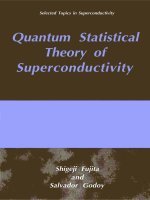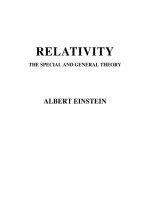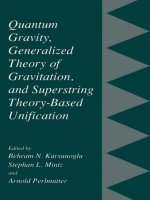- Trang chủ >>
- Khoa Học Tự Nhiên >>
- Vật lý
Kinematical theory of spinning particles classical and quantum m rivas
Bạn đang xem bản rút gọn của tài liệu. Xem và tải ngay bản đầy đủ của tài liệu tại đây (3.52 MB, 360 trang )
Kinematical Theory of Spinning Particles
Fundamental Theories of Physics
An International Book Series on The Fundamental Theories of Physics:
Their Clarification, Development and Application
Editor:
ALWYN VAN DER MERWE,
University of Denver, U.S.A.
Editorial Advisory Board:
JAMES T. CUSHING,
University of Notre Dame, U.S.A.
GIANCARLO GHIRARDI,
University of Trieste, Italy
LAWRENCE P. HORWITZ,
Tel-Aviv University, Israel
BRIAN D. JOSEPHSON,
University of Cambridge, U.K.
CLIVE KILMISTER,
University of London, U.K.
PEKKA J. LAHTI,
University of Turku, Finland
ASHER PERES,
Israel Institute of Technology, Israel
EDUARD PRUGOVECKI,
University of Toronto, Canada
TONY SUDBURY,
University of York, U.K.
HANS-JÜRGEN TREDER,
Zentralinstitut für Astrophysik der Akademie der
Wissenschaften, Germany
Volume 116
Kinematical Theory
of Spinning Particles
Classical and Quantum Mechanical
Formalism of Elementary Particles
by
Martin Rivas
The University of the Basque Country,
Bilbao, Spain
KLUWER ACADEMIC PUBLISHERS
NEW YORK, BOSTON, DORDRECHT, LONDON, MOSCOW
©2002 Kluwer Academic Publishers
New York, Boston, Dordrecht, London, Moscow
All rights reserved
No part of this eBook may be reproduced or transmitted in any form or by any means, electronic,
mechanical, recording, or otherwise, without written consent from the Publisher
Created in the United States of America
Visit Kluwer Online at:
and Kluwer's eBookstore at:
Print ISBN
0-792-36824-X
eBook ISBN
0-306-47133-7
To Merche
This page intentionally left blank.
Contents
List of Figures
xi
Acknowledgment
xvii
Introduction
xix
1. GENERAL FORMALISM
1
1.
Introduction
1
1.1 Kinematics and dynamics
3
2 . Variational versus Newtonian formalism
4
3.
Generalized Lagrangian formalism
8
4 . Kinematical variables
10
4.1 Examples
16
5 .
Canonical formalism
17
6.
Lie groups of transformations
19
6.1 Casimir operators
23
6.2 Exponents of a group
23
6.3 Homogeneous space of a group
25
7 .
Generalized Noether’s theorem
26
8 .
Lagrangian gauge functions
31
9 .
Relativity principle. Kinematical groups
33
10 .
Elementary systems
34
10.1
Elementary Lagrangian systems
39
11 .
The formalism with the simplest kinematical groups
40
2. NONRELATIVISTIC
ELEMENTARY PARTICLES
47
1 .
Galilei group
48
2 .
Nonrelativistic point particle
51
3 .
Galilei spinning particles
55
4 .
Galilei free particle with (anti)orbital spin
63
4.1 Interacting with an external electromagnetic field
67
4.2 Canonical analysis of the system
69
vii
viii
KINEMATICAL THEORY OF SPINNING PARTICLES
4.3
Spinning particle in a uniform magnetic field
72
4.4
Spinning particle in a uniform electric field
84
4.5
Circular zitterbewegung
85
5 .
Spinning Galilei particle with orientation
86
6 .
General nonrelativistic spinning particle
87
6.1
Circular zitterbewegung
90
6.2
Classical non-relativistic gyromagnetic ratio
92
7 .
Interaction with an external field
93
8.
Two-particle systems
98
8.1
Synchronous description
99
9.
Two interacting spinning particles 103
3. RELATIVISTIC
ELEMENTARY PARTICLES 109
1 .
Poincaré group
110
1.1
Lorentz group 113
2 .
Relativistic point particle 118
3 .
Relativistic spinning particles
121
3.1
Bradyons
121
3.2
Relativistic particles with (anti)orbital spin
137
3.3
Canonical analysis
142
3.4
Circular zitterbewegung 145
4 .
Luxons
147
4.1
Massless particles. (The photon) 148
4.2
Massive particles. (The electron) 151
5 .
Tachyons 160
6 .
Inversions
162
7 .
Interaction with an external field
163
4. QUANTIZATION OF
LAGRANGIAN SYSTEMS
169
1 .
Feynman’s quantization of Lagrangian systems 170
1.1
Representation of Observables
173
2.
Nonrelativistic particles 177
2.1
Nonrelativistic point particle
177
2.2
Nonrelativistic spinning particles. Bosons 179
2.3
Nonrelativistic spinning particles. Fermions 182
2.4
General nonrelativistic spinning particle 184
3.
Spinors
185
3.1
Spinor representation on SU(2)
189
3.2
Matrix representation of internal observables
196
3.3
Peter-Weyl theorem for compact groups
196
3.4
General spinors
200
4. Relativistic particles 203
4.1
Relativistic point particle 203
4.2
General relativistic spinning particle
204
4.3
Dirac’s equation 206
Contents ix
4.4 Dirac’s algebra
215
4.5
Photon quantization 217
4.6
Quantization of tachyons 21 8
5. OTHER SPINNING PARTICLE
MODELS
221
1 . Group theoretical models
221
1.1 Hanson and Regge spinning top
221
1.2 Kirillov-Kostant-Souriau model
225
1.3
Bilocal model
228
2 . Non-group based models
232
2.1 Spherically symmetric rigid body
232
2.2 Weyssenhoff-Raabe model
234
2.3
Bhabha-Corben model
240
2.4 Bargmann-Michel-Telegdi model
243
2.5
Barut-Zanghi model
245
2.6
Entralgo-Kuryshkin model
248
6. SPIN FEATURES
AND RELATED EFFECTS
253
1 .
Electromagnetic structure of the electron
254
1.1
The time average electric and magnetic field
254
1.2 Gyromagnetic ratio
264
1.3
Instantaneous electric dipole
266
1.4 Darwin term of Dirac’s Hamiltonian
270
2 .
Classical spin contribution to the tunnel effect
270
2.1 Spin polarized tunneling
278
3 .
Quantum mechanical position operator
279
4.
Finsler structure of kinematical space
285
4.1 Properties of the metric
287
4.2 Geodesics on Finsler space
288
4.3
Examples
290
5 .
Extending the kinematical group
291
5.1
Space-time dilations
292
5.2
Local rotations
293
5.3
Local Lorentz transformations
294
6 .
Conformal invariance
295
6.1
Conformal group
295
6.2
Conformal group of Minkowski space
298
6.3
Conformal observables of the photon
304
6.4
Conformal observables of the electron
305
7 .
Classical Limit of quantum mechanics
306
Epilogue
311
References
315
Index
329
This page intentionally left blank.
List of Figures
3.2
3.1
2.9
2.8
2.7
2.6
2.4
2.5
2.3
1.1
1.2
2.1
2.2
Evolution in {t
,
r
} space.
Evolution in kinematical {
t
,
r
,
α} space.
Charge motion in the C.M. frame.
Initial phase of the charge and initial orientation
(
θ
, φ ) of angular velocity ω.
Motion of the center of charge and center of mass
of a negative charged particle in a uniform mag-
netic field. The velocity of the center of mass is
orthogonal to the field.
Precession of spin around the OZ axis.
Representation of observables U , W and Z in the
center of mass frame.
Zitterbewegung of system described by Lagrangian
(2.137), showing the relation between the spin ob-
servables S, Y and W
Positive charged particles with parallel (
a
) and an-
tiparallel (
b
), spin and magnetic moment.
Representation in the C.M. frame of the motion of
the center of mass of two opposite charged particles
with antiparallel spins. For particle 2, the motion
of its center of charge is also represented. The
interaction produces a chaotic scattering.
Representation in the C.M. frame of the motion
of the center of mass of an electron-positron pair,
producing a bound state.
Motion of the center of charge of the system (3.97)
around the C.M.
Motion of the center of charge of the system (3.98)
around the C.M.
90
93
79
81
89
76
5
43
69
105
106
135
136
xi
xii
KINEMATICAL THEORY OF SPINNING PARTICLES
3.3
3.4
4.1
4.4
4.5
5.1
6.1
6.2
6.3
3.5
4.2
4.3
6.4
6.5
6.6
6.7
6.8
6.9
6.10
6.11
255
256
257
261
141
156
158
207
211
213
214
214
239
259
260
261
261
262
262
262
Center of charge motion of system (3.178) in the
Average retarded (or advanced) electric field (6.3)
Time average < E
r
of the retarded electric field in the directions θ =
retarded electric field in the directions
θ =
π
the time average retarded magnetic field < B
r
the time average retarded magnetic field < B
the time average retarded magnetic field < B
) >,
r
and the dipole field B
0
(
r
), along the direction θ = π
/6.
θ
(
r
) >
and the dipole field B
0
θ
(
r
/4.
θ
(
r
) >
and the dipole field B
0
θ
(
r
/3.
Possible zitterbewegung trajectories of spinning rel-
ativistic particles.
motion of the charge of the electron with
α
e
=
ω
e
= y.
Motion of charge in the C.M. frame.
Orientation in the Pauli-Dirac representation.
Orientation in the Weyl representation.
Space reversal of the electron is equivalent to a
rotation of value
π along S .
Time reversal of the electron produces a particle
of negative energy.
Motion of the particle in the C.M. frame.
Instantaneous electric field of the electron at point
P has a component along – a
⊥
and – β.
and Coulomb field along the OZ axis.
Charge motion and observation point P.
(
r
) > of the radial component
0,
π
/3,
π
/4 and
π
/6.
Time average of the component < E
θ
(
r
) > of the
0,
π
/3,
π
/4
and /6. It goes to zero very quickly. For θ = π /2
it vanishes everywhere.
Radial components of the dipole field B
0
r
(
r
) and
(
r
) >,
along the direction
θ = π /6.
Radial components of the dipole field B
0r
(
r
) and
r
(
r
) >,
along the direction
θ = π
/4.
Radial components of the dipole field B
r
(
r
) and
(
r
along the direction θ =
π
/3.
Time average retarded magnetic field < B
θ
(
r
) >
System of three orthogonal vectors linked to the
C.M. frame.
0
θ
Time average retarded magnetic field < B
), along the direction
θ = π
Time average retarded magnetic field < B
), along the direction
θ = π
List of Figures
xiii
6.12
6.13
6.14
6.15
6.16
6.17
6.18
6.19
6.20
6.21
6.22
6.23
Time average retarded magnetic field < B
r
(r ) >
along the directions
θ = 0, π
/3,
π/4 and π/6 and
its behavior at r = 0. For
θ = π /2 it vanishes everywhere.
Time average retarded magnetic field < B
θ
(r)>
along the directions
θ = 0, /3,
π
π/4 and π/6 and
its behavior at r = 0.
Time average radial component < E
r
(r) > of the
advanced electric field in the directions
θ = 0,
π
/3, π/4
and π/6.
Electron charge motion in the C.M. frame.
A basis for vectors (
a
) and bivectors (pseudovec-
tors) (
b
) of Pauli algebra.
Triangular potential barrier.
Electron beam into a potential barrier. A classical
spinless electron never crosses the dotted line. A
spinning particle of the same energy might cross
the barrier.
Potential Energy of an
α-particle in the electric
field of a nucleus.
Kinetic Energy during the crossing for the values
a = b =1.
Kinetic Energy during the crossing for the values
a = 1, b = 10.
Classical and Quantum Probability of crossing for
different potentials.
Classical Limit of Quantum Mechanics.
263
263
263
267
269
271
272
272
274
275
277
307
This page intentionally left blank.
If a spinning particle
is not quite a point
particle, nor a solid
three dimensional top,
what can it be?
A. O. Barut
Eppure si muove . . .
(the electron)
This page intentionally left blank.
ACKNOWLEDGMENTS
If in any endeavour one has such lovely and unconditional supporters
as my wife Merche and daughters Miren and Edurne, the goal will be
achieved. Thanks to them for inspiring love and courage.
The analysis of dynamical systems, when an analytical solution does
not exist, is in general a difficult task. In those cases, we always have the
possibility of making an alternative numerical interpretation. But nu-
merical analysis requires quite often a personal skill in computing or the
collaboration of a computer department. The numerical computer pro-
gram Dynamics Solver, developed by Juan M. Aguirregabiria has proven
to be a handy tool, even for an inexperienced theoretical physicist. Ex-
tensive use of this package has been done for the analysis of many of the
examples contained in this book. I enthusiastically recommend its use,
even for teaching purposes. I am very much indebted to him by his help
and for the many years of sharing life and duties.
Thanks to Aníbal Hernández for pointing out, even in these difficult
times, several references related to the zitterbewegung.
I would like to mention the special collaboration of Sanjay Jhingan
for a critical reading of several chapters of the manuscript.
Professor Asim O. Barut’s quotation in the previous page is taken
from a document kindly supplied by professor Erasmo Recami.
Thanks to the editorial board of Kluwer Academic, in particular to
professor Alwyn Van der Merwe for his stimulating suggestions.
I acknowledge a grant from the Spanish Ministerio de Educación y
Cultura during the final steps of the completion of the manuscript.
xvii
This page intentionally left blank.
Introduction
After the success of Dirac’s equation the electron spin was considered
for years as a strict relativistic and quantum mechanical property, with-
out a classical counterpart. This is what one basically reads in some ex-
cellent textbooks, mainly written by the mid 20
th
century. The recently
re-edited book ‘The Story of Spin’ by Tomonaga, who reviews the main
discoveries during a period of 40 years, is not an exception. But, never-
theless, one often reads in other textbooks and research works statements
which mention that the spin is neither relativistic nor a quantum me-
chanical property of the electron, and that a classical interpretation is
also possible, giving some answers to this subject. The literature about
it, not so extensive as the quantum one, is important.
One of the challenges while writing this book was to give an answer to
Professor Barut’s quotation, in the preliminary pages. Is it possible to
give a comprehensive description, let us say at an undergraduate level,
of an elementary particle in the form of what one usually thinks should
be the description of a rotating small object? The partial qualitative
answer is contained in the other preceding quotation, that, according to
some not well confirmed Legend, was pronounced sotto voce by Galileo
Galilei at the end of his Inquisition trial. In that case this statement was
related to Earth’s motion. But the electron also moves and the classical
description of this motion is what we have been looking for.
The present book is an attempt to produce a classical, and also a quan-
tum mechanical, description of spin and the related properties inherent
to it such as the so called zitterbewegung and the associated intrinsic
dipole structure of elementary particles. The relationship between the
classical and the quantum mechanical description of spin will show how
both formalisms are able to complement each other, thus producing, for
instance, a kinematical explanation of the gyromagnetic ratio of leptons
and charged W
±
bosons.
xix
xx
KINEMATICAL THEORY OF SPINNING PARTICLES
But at the same time, this book also presents a new formalism, based
upon group theory, to describe elementary particles from a classical and
quantum point of view. In this way the structure of an elementary parti-
cle is basically related to the kinematical group of space-time transforma-
tions that implements the Special Relativity Principle. It is within the
kinematical group where we have to look for the independent variables
to describe an elementary object. This relationship has been sought for
years and has produced a lot of literature, but is so intimate that it has
not been unveiled yet, unfortunately.
tary particles. Nevertheless, those readers with low group theoretical
The book is organized as follows. The first chapter contains the ba-
sic definitions and general Lagrangian formalism for dealing with clas-
sical elementary particles, and also a precise mathematical definition
of elementary particle is given. Some group theoretical background is
necessary to properly understand the intimate connection between the
concept of elementarity and the kinematical group of symmetries. This
is why we have entitled the book as a kinematical th eory of elemen-
baggage, will be acquainted with it after the analysis of the first mod-
els. A careful reading of the last section of this chapter shows how the
formalism works with the simplest kinematical groups, preparing the
ground for further theoretical analysis for larger symmetry groups. This
is what is done in Chapters 2 and 3, which are devoted to the analysis of
non-relativistic and relativistic classical particles. There we consider as
the basic symmetry group, the Galilei and Poincaré group, respectively.
Different models are explored thus showing how the spin arises when
compared with the point particle case.
Chapter 4 takes the challenge of quantizing the previously developed
models. This task is accomplished by means of Feynman’s path integral
approach, because the classical formalism has a well-defined Lagrangian,
written in terms of the end-point variables of the variational approach.
It is shown how the usual one-particle wave equations can be obtained,
by using the methods of standard quantum mechanics, after the choice
of the appropriate complete commuting set of operators. These opera-
tors are obtained from the algebra produced by the set of generators of
the kinematical group in the corresponding irreducible representation.
It is fairly simple to get Dirac’s equation, once we identify the different
classical observables with their quantum equivalent. One of the salient
features is the determination of the kind of classical systems that, ac-
cording to the classical spin structure, quantize either with integer or
half integer values.
I have included in Chapter 5 several alternative models of classical
spinning particles, taken from the literature, by several authors. It is
INTRODUCTION xxi
a collection of models, which in general cannot be found in textbooks,
although some of them were published as research articles even before
Dirac’s theory of the electron. This review is far from being complete
but it comprehends most of the models quoted in the literature of this
subject. They are discussed in connection with those models obtained
from our formalism to show the scope of the different approaches. My
apologies for not being as exhaustive as desirable.
The last chapter is devoted to some features, either classical or quan-
tum mechanical, that can be explained because of the spin structure of
the particles. It is only a sample to show how, by applying the formalism
to some particular problems in which spin plays a role, we can obtain an
alternative interpretation that gives a new perspective to old matters.
The subject of the book is already at a seminal level and now needs
a deeper improvement. For some readers the contents of the following
pages will be considered as a pure academic exercise but, even in this
case, it opens new fields of research. If after reading these chapters
you have a new view and conceptual ideas concerning particle physics,
I will take for granted the time and effort I enjoyed in producing this
manuscript. Your criticism will always be welcome.
Martín Rivas
Bilbao, June 2000
This page intentionally left blank.
Chapter 1
GENERAL FORMALISM
This chapter is devoted to general considerations about kinematics
and dynamics and the differences between Newtonian dynamics and
variational formalism when the mechanical system is a spinning par-
ticle. These considerations lead us in a quite natural way to work in
a Lagrangian formalism in which Lagrangians depend on higher order
derivatives. The advantage is that we shall work in a classical formal-
ism closer to the quantum one, as far as kinematics and dynamics are
concerned. We shall develop the main items such as Euler-Lagrange
equations, Noether’s theorem and canonical formalism in explicit form.
The concept of the action of Lie groups on manifolds will be introduced
to be used for describing symmetry principles in subsequent chapters
for both relativistic and nonrelativistic systems. In particular we shall
express the variational problem not only in terms of the independent
degrees of freedom, but also as a function of the end point variables of
the corresponding action integral. We shall call these variables the kine-
matical variables of the system. The formalism in terms of kinematical
variables proves to be the natural link between classical and quantum
mechanics when considered under Feynman’s quantization method. It is
in terms of the kinematical variables that a group theoretical definition
of a classical elementary particle will be stated.
1.
INTRODUCTION
Historically quantum mechanics has been derived from classical me-
chanics either as a wave mechanics or by means of a canonical com-
mutation relation formalism or using the recipes of the so-called ‘corre-
spondence principle’. Today we know that none of these formalisms are
necessary to quantize a system.
1
2 KINEMATICAL THEORY OF SPINNING PARTICLES
Axiomatic quantum mechanics and the algebraic approach show that
it is possible to construct a quantum mechanical formalism without any
reference to a previous classical model. But nevertheless, to produce a
detailed quantum mechanical analysis of a concrete experiment we need
to work within a particular and specific representation of the C
*
-algebra
of observables, i.e., we need to define properly the Hilbert space of pure
states H, to obtain the mathematical representation of the fundamental
observables either as matrix, integral or differential operators. In general
H is a space of complex squared integrable functions
(
X), defined on
a manifold X, in which some measure dµ
(
x) is introduced to work out
the corresponding Hermitian scalar product. But all infinite-dimensional
separable Hilbert spaces are isomorphic and it turns out that the selec-
tion of the manifold X and the measure dµ
(
x) is important to show the
detailed mathematical structure of the different observables we want to
work with.
For instance, on the Hilbert space it is difficult to define the
angular momentum observable J. We need at least a Hilbert space of the
form
although isomorphic to the previous one, to obtain a non-
trivial representation of the angular momentum operator
This implies that the support of the wave-functions must be a three-
dimensional manifold or that the basic object we are describing is
at least a point moving in three-dimensional space. It is nonsense from
the physical point of view to define the angular momentum of a point
moving in a one-dimensional universe. But this election of the manifold
is dictated by the classical awareness we have about the object we
want to describe. Classical mechanics, if properly developed, can help
to display the quantum mechanical machinery.
Newtonian mechanics is based upon the hypothesis that the basic
object of matter is a point, with the property of having mass m and
spin zero. Point dynamics is described by Newton’s second law. It
supplies in general differential equations for the position of the point
and is expressed in terms of the external forces. Larger bodies and
material systems are built from these massive and spinless points, and
taking into account the constraints and interactions among the different
parts of the system, we are able to derive the dynamics of the essential
and independent degrees of freedom of any compound system of spinless
particles.
Now, let us assume that we have a time-machine and we jump back to
Newton’s times, we meet him and say: ‘Sir, according to the knowledge
we have in the future where we come from, elementary objects of nature
have spin, in addition to mass m, as a separate intrinsic property. What
can we do to describe matter?’ Probably he will add some extra degrees









